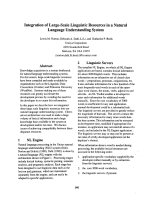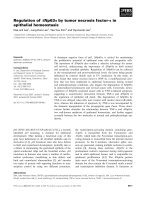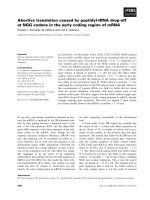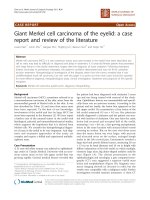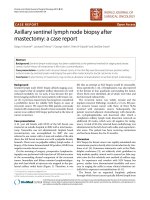báo cáo khoa học: "Severe sepsis caused by Aeromonas hydrophila in a patient using tocilizumab: a case report" pps
Bạn đang xem bản rút gọn của tài liệu. Xem và tải ngay bản đầy đủ của tài liệu tại đây (1.13 MB, 3 trang )
CAS E REP O R T Open Access
Severe sepsis caused by Aeromonas hydrophila in
a patient using tocilizumab: a case report
Kenji Okumura
*
, Fumihiro Shoji, Masaki Yoshida, Atsushi Mizuta, Ichiro Makino and Hidefumi Higashi
Abstract
Introduction: Aeromonas species do not commonly cause disease in humans. However, when disease is seen, it
often occu rs in patients with underlying immunosuppression or malignancy and has a high fatality rate.
Case presentation: A 72-year-old Japanese woman with rheumatoid arthritis treated with tocilizumab (which has
an immunosuppressive effect) presented with severe epigastric pain. She had a fever with chills, hypotension and
jaundice. She was diagnosed with acute suppurative cholangitis and treated with cefoperazone-sulbactam and an
endoscopic drainage was performed. Jaundice was slightly improved, but the shock state and inflammatory
reactions were prolonged as typical of septic shock. On the second day after admission, an electrocardiogram
showed ST segment elevation and echocardiography showed ventricular wall dysfunction. Coronary arteries were
patent in coronary angiography and she was diagnosed with stress-induced cardiom yopathy. Blood cultures
showed Aeromonas hydrophila. A stool culture was negative for A. hydrophila. On day six, her white blood cell
count and neutrophils were normalized and cefoperazone-sulbactam treatment was halted. Left ventricular
function normalized on day twelve and a laparoscopic c holecystectomy for cholelithiasis was performed on the
16th day of hospitalization. A culture from the bile showed A. hydrophila. Eighteen days after surgery, tocilizumab
treatment was restarted and there were no complications. Two months after restarting tocilizumab, our patient is
stable without any serious events.
Conclusion: We present a rare case of A. hydrophila sepsis and acute suppurative cholangitis in an elderly patient
with gallstones and rheumatoid arthritis using tocilizumab. This clinical course may suggest that preemptive
treatment for cholelithiasis prior to using molecular-targeting agents might be feasible in elderly patients.
Introduction
Aero monas hydrophila is distributed widely in fres h and
salt water, and is also found in food, treated dri nking
water, domestic water supplies and hospital water supply
systems [1,2]. Typically, patients acquire Aeromonas spe-
cies by oral consumption or direct contact with con-
taminated water or seafood. Thus, gastroenteritis and
mild-to-moderate soft-tissue infections are the most
common present atio ns. In immunocompromised indiv i-
duals, such as patients with cirrhosis, malignant diseases,
chronic renal failure, diabetes mellitus or steroid use,
Aerom onas spp. cause substantial mortality from a wide
spectrum of infections. These include hepatobiliary
infection, invasive skin and soft-tissue infections, pri-
mary bacteremia, burn infections, pleuropulmon ary
infection, meningitis and endocarditis [1,2]. The species
A. hydrophila, A. caviae,andA. veronii biovar sobria
account for more than 85% of human infections [1,2].
Aeromonas infection is often polymicrobial and fatality
rates range from 28% to 46% in cases of bacteremia,
mostly caused by A. hydrophila and A. veronii biovar
sobria [1-3]. Tocilizumab, developed as a treat ment of
rheumatoid arthritis, is a humanized anti-interleukin-6
receptor monocl onal antibody, and can cause infecti ons
as adverse events. We report here a rare case of A.
hydrophila sepsis and acute suppurative cholangitis in
an elderly patient with rheumatoid arthritis using
tocilizumab.
Case presentation
A 72-year-old Japanese woman was admitted with
severe epigastric pain and vomiting. She had a history of
rheumatoid arthritis treated with tocilizumab every four
* Correspondence:
Department of Surgery, Nippon Steel Yawata Memorial Hospital, 1-1-1,
Harunomachi, Yahatahigashi-ku, Kitakyushu 805-8508, Japan
Okumura et al. Journal of Medical Case Reports 2011, 5:499
/>JOURNAL OF MEDICAL
CASE REPORTS
© 2011 Okumura et al; licensee BioMed Central Ltd. This is an Open Access articl e distributed under the terms of the Creative
Commons Attribution License ( which permits unr estricted use, distribution, and
reproduction in any medium, provided the original work is properly cited.
weeks. On examination, she had a temperature of 39.2°C
with chills. Her blood pressure was 77/46 mmHg, with a
heart rate of 96 bpm. She was jaundiced, but had no
sig ns of palmar eryt hema, ankle edema, finger clubb ing,
spider nevi or evidence of skin injury or infection. She
had abdominal pain with right upper-quadrant discom-
fort and a positive Murphy’ s sign. Laboratory results
showed the following: white blood cell count 7600/μL
(normal range: 3100-8800 μL), neutrophils 97.7% (nor-
mal range: 50-70%), C-reactive protein 2.16 mg/dL (nor-
mal ran ge: 0-0.25 mg/dL), a platelet count of 150 × 10
9
/
μL (normal range: 140-440 × 10
9
/μL), aspartate transa-
minase 266 IU/L (normal range: 13-33 IU/L), alanine
transaminase 432 IU/L (normal rang e: 6-27 IU/L), and
alkaline phosphatase 890 IU/L (normal range: 115-359
IU/L). In addition, her total bilirubin was 7.0 mg/dL
(normal range: 0.3-1.5 mg/dL), direct bilirubin 5.2 mg/
dL (normal range: 0-0.2 mg/dL), gamma glutamyl trans-
ferase, 342 IU/L (normal range: 10-60 IU/L), protein 59
g/L (normal range: 67-83 g/L) and albumin 33 g/L (nor -
mal range: 40-50 g/L). An abdominal ultrasonography
revealed an enlarged gall bladder with stones, and dila-
tion of her intrahepatic a nd common bile ducts. Com-
puted tomography (CT) showed cholelithiasis,
choledocholithiasis, dilated common bile duct with a
calcified stone and normal liver shape (Figure 1). Our
patient was diag nosed with sepsis due to acute suppura-
tive cholangitis. Blood samples were collected immedi-
ately and cefoperazone-sulbactam (1 g intravenously
every 12 hours) was started for biliary tract infection.
Endoscopic retrograde cholangiopancreatography was
performed and two stones were drained along with
sludge. Vasopressors were used to manage shock. Jaun-
dice was slightly improved, but the shock state was pro-
longed as is typical of this condition. On the second day
following admission, she vomited and exhibited hypo-
tension with bradycardia. An electrocardiogram showed
ST segment elevation at I and aVL. Echocardiography
showed left posterolateral ventricular wall dysfunction.
Coronary angiography showed patent coronary arteries
and she was diagnosed with stress-induced cardiomyo-
pathy. Blood cultures were positive for A. hydrophila
and Kl ebsiel la pneum oniae, both of which were suscep-
tible to cefoperazone-sulbactam. A. hydrophila was
resistant to penicillin, ampicillin, ampicillin-sulbactam,
and first- and second-gen eration cephalosporins, and
susceptible to piperacillin , third-generation cephalospor-
ins, aminoglycosides, carbapenems, tetracyclines, tri-
methoprim-sulfamethoxazole and fluoroquinolones. A
stool culture was negative for A. hydrophila and no
malignancy, cirrhosis, chronic renal failure or diabetes
mellitus was evident in additional investigations. On day
six, her white blood cell count and the percentage of
neutrophils were normalized and cefoperazone-sulbac-
tam treatment was halted. Left ventricular function nor-
malized on day twelve and laparoscopic cholecystectomy
for cholelithiasis was performed on the 16th day of hos-
pitalization. A culture from her bile showed only A.
hydrophila. Eighteen d ays after surgery, tocilizumab
treatment was restarted and there were no complica-
tions. Two months after restar ting tocilizumab, our
patient is stable without any serious events.
Discussion
Aeromonas spp. are ubiquitous mobile Gram-negative
rods found in water sources. They cause a wide range of
human illness; possible routes of transmission include
contaminated food and exposur e of wounds to environ-
ments that contain the pathogen [1,4]. Severe A. hydro-
phila infections usually involve immunocompromised
people with chronic illness [1,2]. Aeromonas spp. pro-
duce a beta-lactamase, which makes them resistant to
ampicillin and first-generation cephalosporins. The anti-
microbial agents most active against Aeromonas are the
third-generation cephalosporins, imipenem and fluoro-
quinolones [5,6].
The frequency of acut e suppurative cholangitis due to
Aeromonas is low (less than 3%) [1,3]. Aeromo nas hepa-
tobiliary infections are commonly associated with chole-
lithiasis, choledocholithiasis, malignancy, other
immunocompromised conditions and recent surgical
procedures [1-3].
Tocilizumab, used for the treatment of rheumatoid
arthritis, is a humanized monoclonal an tibody against
interleukin-6, a cytokine that plays a multifunctional
and important role in the immune response [7]. Infec-
tion was the most common adverse event associated
with tocilizumab in clinical trials [7,8]. Serious bacterial,
viral or fungal infections can occur when using
Figure 1 CT scan showing cholelithiasis (white arrow),
choledocholithiasis and dilated common bile duct (black
arrow) with a calcified stone.
Okumura et al. Journal of Medical Case Reports 2011, 5:499
/>Page 2 of 3
tocilizumab, such as tuberculosis [8]. The rate of serious
infections was 3.6 events per 100 patient-years, but the
overall rate of fatal infections was low (0.13 events per
100 patient-years) [7].
In this immunocompromised patient receiving treat-
ment with tocilizumab and with known cholelithiasis,
sepsis with A. hydrophila and Klebsiella pneumoniae
developed secondary to pyogenic cholangitis due to cho-
ledocholoth iasis. No gastrointestinal symptoms preceded
or were concurrent with sepsis, and a stool culture was
negative for A. hydrophila. There were no signs of soft
tissue infection and no p revious episodes of treating
infections with antibiotics during the past year. Only A.
hydrophila was detected in the gall bladder after the
cholangitis had improved. These results may suggest
that A. hydrophila was carried in the biliary tract and
that stone obstruction of the biliary tract caused s epsis
with ascending infection of Klebsiella pneumoniae.No
other infectious pathway seems likely.
In healthy individuals, bacteria are not found in the
gall bladder, but in patie nts with gallstones the percen-
tage of positive cultures depends upon the severity of
the disease and age [9]. Thus, preemptive treatment for
cholelithiasis prior to using molecular-targeting age nts
might be feasible in elderly patients.
Conclusion
We present a rare case of A. hydrophila sepsis and acute
suppurative cholangitis in a patient with gallstones and
rheumatoid arthritis using tocilizumab.
Consent
Written informed consent was obtained from the patient
for publication of this manuscript and the accompanying
image. A copy of the written consent is available for
review by the Editor-in-Chief of this journal.
Authors’ contributions
KO undertook the gathering of information for this case and was a major
contributor in writing the manuscript. FS conceived the manuscript and was
a major contributor to the manuscript. All authors read and approved the
final manuscript.
Competing interests
The authors declare that they have no competing interests.
Received: 25 March 2011 Accepted: 5 October 2011
Published: 5 October 2011
References
1. Janda JM, Abbott SL: The genus Aeromonas: taxonomy, pathogenicity,
and infection. Clin Microbiol Rev 2010, 23:35-73.
2. Figueras MJ: Clinical relevance of Aeromonas. Rev Med Microbiol 2005,
16:145-153.
3. Chan FK, Ching JY, Ling TK, Chung SC, Sung JJ: Aeromonas infection in
acute suppurative cholangitis: review of 30 cases. J Infect 2000, 40:69-73.
4. Kuo-Chun L, Po-Tsung Y, Cheng L: Necrotizing fasciitis caused by
inconspicuous infection of Aeromonas hydrophila in
immunocompromised host. JSCR 2010, 7:2.
5. Ko WC, Chuang YC: Aeromonas bacteremia: review of 59 episodes. Clin
Infect Dis 1995, 20:1298-1304.
6. Clark NM, Chenoweth CE: Aeromonas infection of the hepatobiliary
system: report of 15 cases and review of the literature. Clin Infect Dis
2003, 37:506-513.
7. Patel AM, Moreland LW: Interleukin-6 inhibition for treatment of
rheumatoid arthritis: a review of tocilizumab therapy. Drug Des Devel Ther
2010, 4:263-278.
8. Nishimoto N, Ito K, Nobuhiro T: Safety and efficacy profiles of tocilizumab
monotherapy in Japanese patients with rheumatoid arthritis: meta-
analysis of six initial trials and five long-term extensions. Mod Rheumatol
2010, 20:222-232.
9. Csendes A, Burdiles P, Maluenda F, Diaz JC, Csendes P, Mitru N:
Simultaneous bacteriologic assessment of bile from gallbladder and
common bile duct in control subjects and patients with gallstones and
common bile duct stones. Arch Surg 1996, 131:389-394.
doi:10.1186/1752-1947-5-499
Cite this article as: Okumura et al.: Severe sepsis caused by Aeromonas
hydrophila in a patient using tocilizumab: a case report. Journal of
Medical Case Reports 2011 5:499.
Submit your next manuscript to BioMed Central
and take full advantage of:
• Convenient online submission
• Thorough peer review
• No space constraints or color figure charges
• Immediate publication on acceptance
• Inclusion in PubMed, CAS, Scopus and Google Scholar
• Research which is freely available for redistribution
Submit your manuscript at
www.biomedcentral.com/submit
Okumura et al. Journal of Medical Case Reports 2011, 5 :499
/>Page 3 of 3
